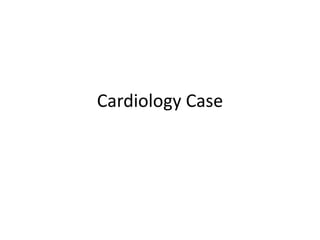
Cardiology case 1
- 2. History • A 39- year-old south Asian man presented to the ER with a 3-week history of chest pain. This pain is burning, central at the lower chest and was not clearly associated with exertion. It did not radiate and there was no associated symptoms. He smokes 20 cigarettes per day. • The was no past medical history. • His father died at the age of 41 with a heart attack. There is family history of diabetes.
- 3. History • He had presented twice in the preceding 3 weeks. On both previous occasions the ECG and cardiac enzymes was reported to be normal. • On the second occasion the patient was diagnosed to have GERD and was prescribed ranitidine 150mg bd.
- 4. Examination • The patient was anxious but pain free at the time of exam. • Pulse:75 bpm regular • BP: 145/80 mmHg • O2 Saturation: 98% on room air • Resp. rate: 14 breath/min
- 5. Examination • Cardiovascular exam was unremarkable. • Chest pain was not reproduced with manual pressure.
- 6. ECG
- 7. • Cardiac Troponin I measurements on admission and 12 hours after were normal.
- 8. Question 1 What is the differential diagnosis for this presentation?
- 9. DD of chest pain Source Type Radiate Tender Posture Breath food NTG movement ACS Visceral Lt arm - - - - + neck jaw Dissecting Visceral Back or as - - - - +/- aneurysm ACS Pericardial/ Somatic - +/- + + - - Pleural Lung tissue Visceral/ - - - + - - somatic Pneumothorax Visceral/ - - - - - - somatic MSK Somatic - + + + - - Nerve Somatic/ +/- + +/- - - - neuropathic GI Visceral + +/- - - + +/-
- 10. • In this case, the pain is not consistent with any of the common etiologies. • In 1 of each 5 cases diagnosed with ACS, the patient was initially discharged from ER with another diagnosis. • Misdiagnosis is most common in women <55 years, non-cucasians and those with normal ECG
- 11. • Atypical presentations of ACS are not uncommon, particularly in young(25- 40), elderly (>75), diabetics, and women. • Ischemic pain can be rest pain, epigastric, stabbing, or with some pleuritic features. • ACS can present with increasing dyspnea without pain.
- 12. Question 2 • What is the D. D. of the patients ECG?
- 13. ECG interpretation • Sinus rhythm at a rate of 66 bpm • Left axis deviation • Dominant R-waves in V1-V3 • Low voltage R-waves in inferior and lateral leads. • T-waves are upright anteriorly and biphasic laterally
- 14. DD of Dominant R-wave in V1 1. Right ventricular hypertrophy (the most common cause). – Usually associated with repolarization abnormality causing down sloping ST-segment depression and T-wave inversion – Usually associated with right axis deviation
- 16. 2. Posterior myocardial infarction – Up right T-waves in V1 – Left axis deviation due to associated inferior MI
- 18. 3. Right bundle branch block: – QRS duration is prolonged – Typical wave form ( rSR’ in V1 and RS in V6)
- 19. 4. WPW syndrome – If left sided accessory pathway – Delta wave is present
- 20. 5. Incorrect ECG leads placement 6. Dextrocardia 7. Normal variant 8. Rare causes: Duchenne/Becker myopathy and constrictive pericarditis
- 21. Question 3 What is the next step in management for this patient?
- 22. • This patient most properly has post- infarction angina after posterior MI • This patient was referred for coronary angiography that showed critical proximal stenosis in dominant right coronary artery. • Angioplasty and stenting of RCA was done with good recovery.
